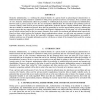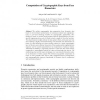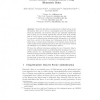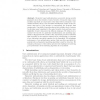125
click to vote
TSMC
2010
14 years 7 months ago
2010
In recent years the protection of biometric data has gained increased interest from the scientific community. Methods such as the fuzzy commitment scheme, helper data system, fuzzy...
109
Voted
PAMI
2007
15 years 9 days ago
2007
— In this paper, we investigate the use of brain activity for person authentication. It has been shown in previous studies that the brain-wave pattern of every individual is uniq...
136
click to vote
SSWMC
2004
15 years 2 months ago
2004
Biometric authentication, i.e. verifying the claimed identity of a person based on physiological characteristics or behavioral traits, has the potential to contribute to both priv...
109
Voted
CMS
2003
15 years 2 months ago
2003
We outline cryptographic key–computation from biometric data based on error-tolerant transformation of continuous-valued face eigenprojections to zero-error bitstrings suitable f...
117
Voted
ACNS
2010
Springer
15 years 4 months ago
2010
Springer
Secure sketches are useful in extending cryptographic schemes to biometric data since they allow recovery of fuzzy secrets under inevitable noise. In practice, secrets derived from...
100
click to vote
AVBPA
2003
Springer
15 years 6 months ago
2003
Springer
Abstract. A biometric authentication system operates by acquiring biometric data from a user and comparing it against the template data stored in a database in order to identify a ...
104
click to vote
EUROCRYPT
2005
Springer
15 years 6 months ago
2005
Springer
Biometric data offer a potential source of high-entropy, secret information that can be used in cryptographic protocols provided two issues are addressed: (1) biometric data are n...
136
click to vote
ACISP
2005
Springer
15 years 6 months ago
2005
Springer
Biometric based authentication can provide strong security guarantee about the identity of users. Security of biometric data is particularly important as compromise of the data wil...
96
Voted
CCS
2007
ACM
15 years 7 months ago
2007
ACM
We show that there is a direct relation between the maximum length of the keys extracted from biometric data and the error rates of the biometric system. The length of the bio-key...
114
click to vote
CVPR
2007
IEEE
15 years 7 months ago
2007
IEEE
Since biometric data cannot be easily replaced or revoked, it is important that biometric templates used in biometric applications should be constructed and stored in a secure way...




